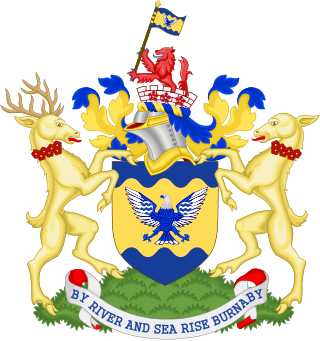
The coat of arms of the state of New York was formally adopted in 1778, and appears as a component of the state's flag and seal.

The coat of arms of Prince Edward Island, officially the King's Arms in Right of Prince Edward Island, are the coat of arms of Prince Edward Island, being the arms of King Charles III in right of the province. They were created when the shield and motto in the achievement were granted in 1905 by royal warrant from King Edward VII. The latest iteration was given by the Canadian Heraldic Authority in 2002.

The coat of arms of Nunavut was granted by a warrant of Roméo LeBlanc, Governor General of Canada, dated 31 March 1999, one day before the territory of Nunavut, Canada, was created. The same document specified the flag of Nunavut.

The coat of arms of the Bahamas contains a shield with the national symbols as its focal point.

The coat of arms of Belize was adopted upon independence, and the current coat of arms is only slightly different from that used when Belize was a British colony.

In heraldry, an ordinary is one of the two main types of charges, beside the mobile charges. An ordinary is a simple geometrical figure, bounded by straight lines and running from side to side or top to bottom of the shield. There are also some geometric charges known as subordinaries, which have been given lesser status by some heraldic writers, though most have been in use as long as the traditional ordinaries. Diminutives of ordinaries and some subordinaries are charges of the same shape, though thinner. Most of the ordinaries are theoretically said to occupy one-third of the shield; but this is rarely observed in practice, except when the ordinary is the only charge.

The coat of arms of Toronto is a heraldic symbol used to represent the city Toronto. Designed by Robert Watt, the Chief Herald of Canada at the time, for the City of Toronto after its amalgamation in 1998. The arms were granted by the Canadian Heraldic Authority on 11 January 1999.

The coat of arms of Victoria is the official heraldic symbol of the Australian state of Victoria. Victoria was the second state of Australia to gain arms, granted on 6 June 1910 by royal warrant of King George V. The state had been named in 1851 after his grandmother, who was in reign at the time. The final version of the arms was granted 28 March 1978 in the royal warrant issued by Queen Elizabeth II.

The coat of arms of Sunderland is the official heraldic arms of the City of Sunderland in England.

The great seal of the state of Delaware was first adopted on January 17, 1777, with the current version being adopted April 29, 2004. It contains the state coat of arms surrounded by an inscription.

The coat of arms of Uganda was adopted three weeks before the proclamation of independence by the Uganda Legislative Council. On 1 October 1962 the arms were approved by Governor of Uganda Walter Coutts, and formally established by law on 9 October.

Edmonton was a local government district in north-east Middlesex, England, from 1850 to 1965.

The flag of the British Antarctic Territory was granted on 21 April 1998. It features the coat of arms granted on 1 August 1963, a year after the British Antarctic Territory, a British Overseas Territory, was created. Previously, the Territory was a part of the Falkland Islands Dependencies and used the same flag. On 30 May 1969, a blue ensign with the British Antarctic Territory coat of arms in the fly was introduced as a civil ensign.

The coat of arms of Sierra Leone, were developed by the College of Arms and granted in 1960.

The coat of arms of the British Antarctic Territory was first granted in 1952, when the territory was still a dependency of the Falkland Islands.

The Coat of arms of West Yorkshire Metropolitan County Council was granted in 1975 to the new Metropolitan county council created in the previous year. The County Council was abolished in 1986 under the provisions of the Local Government Act 1985 and consequently the arms are no longer used. The current West Yorkshire Combined Authority uses a wordmark consisting of the authorities name.

The coat of arms of Malawi is based on the earlier heraldic arms of Nyasaland. It is supported by a lion and a leopard, above a scroll reading "Unity and Freedom". A rising sun in a black field, like in the lower field in the shield, is also present in the flag of Malawi.

The Coat of arms of Penang is largely based on the coat of arms of Penang first granted to the Settlement of Penang, then in the Federation of Malaya, by a Royal Warrant of King George VI dated 11 September 1949.

The coat of arms of Burnaby was granted originally to the Corporation of the District of Burnaby by the Canadian Heraldic Authority in 1991, and then reconfirmed for the city of Burnaby in 2005 as the corporation's successor. The grant included the full coat of arms as well as a flag and a badge, both derived from the arms.

The coat of arms of Oxford is the official heraldic arms of Oxford, England, used by Oxford City Council.




















